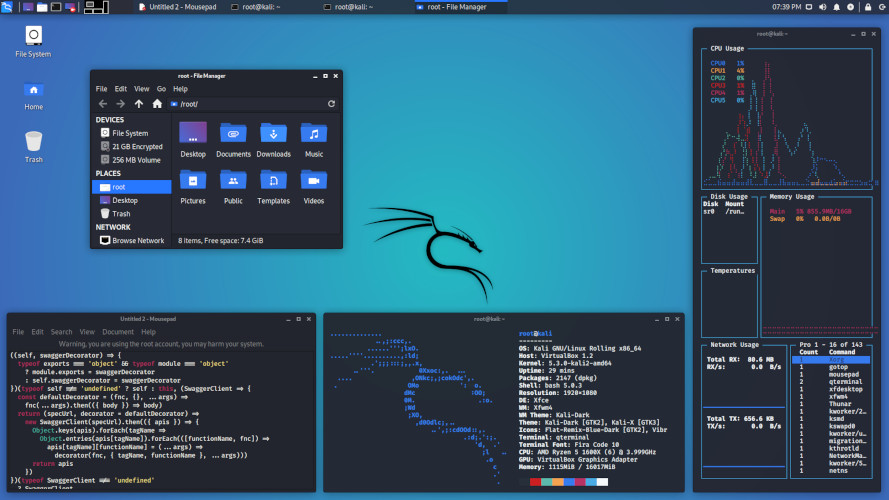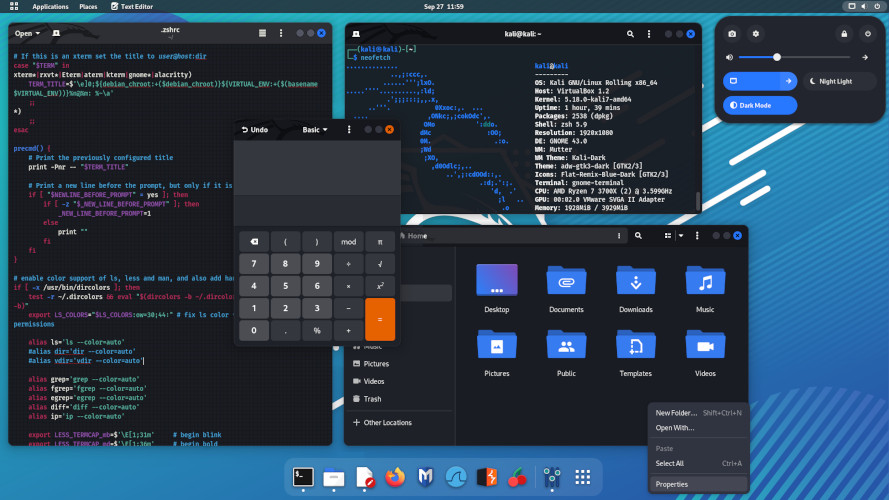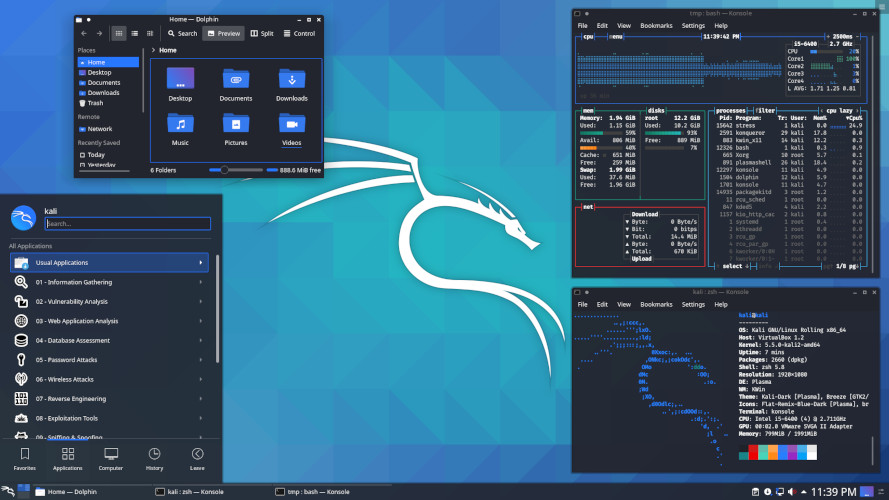
Kali Linux is an open-source, Debian-based Linux distribution geared towards various information security tasks, such as Penetration Testing, Security Research, Computer Forensics and Reverse Engineering.
Kali Linux, with its BackTrack lineage, has a vibrant and active community. There are active Kali forums, IRC Channel, Kali Tools listings, an open bug tracker system, and even community provided tool suggestions.
The Kali Linux penetration testing platform contains a vast array of tools and utilities. From information gathering to final reporting, Kali Linux enables security and IT professionals to assess the security of their systems.
Using Kali in an environment where you don't want to draw attention to yourself? Kali Undercover is the perfect way to not stand out in a crowd.
A mobile penetration testing platform for Android devices, based on Kali Linux. Kali NetHunter is made up of an App, App Store, Kali Container and KeX
Win-KeX provides a full Kali Desktop Experience for Windows WSL. Applications started via Kali's panel will share the desktop with Microsoft Windows applications.
Cheap & low powered devices, which make for great leave behind devices. Modern ARM based laptops provide high speed with long battery life as an assessment platform.
Single or multiple boot Kali, giving you complete control over the hardware access (perfect for in-built WiFi and GPU), enabling the best performance.
Hosting providers which have Kali Linux pre-installed, ready to go, without worrying about looking after the infrastructure.
Using Docker or LXD, allows for extremely quick and easy access to all of Kali's tools, without the overhead of a isolated virtual machine.
A mobile penetration testing platform for Android devices, based on Kali Linux. Kali NetHunter consists of an NetHunter App, App Store, Kali Container, and KeX.
Kali in your pocket, ready to go with Live Boot. Your Kali, always with you, without altering the host OS, plus allows you to benefit from hardware access.
VMware, VirtualBox & QEMU pre-built images ready to go. Allowing for a Kali install as bare as possible, with additional features such as snapshots, without altering the host OS. And we have vagrant images too.
WSL is included out of the box with modern Windows. You can then start to use Kali (and Win-KeX) without any installing any extra software.
Xfce is a lightweight desktop environment for UNIX-like operating systems. It aims to be fast and low on system resources, while still being visually appealing and user friendly.
Xfce consists of separately packaged parts that together provide all functions of the desktop environment, but can be selected in subsets to suit user needs and preferences. This is Kali's default desktop environment.


Every part of GNOME Shell has been designed to make it simple and easy to use. The Activities Overview is an easy way to access all your basic tasks. A press of a button is all it takes to view your open windows, launch applications, or check if you have new messages. Having everything in one place is convenient and means that you don't have to learn your way through a maze of different technologies.
Plasma is made to stay out of the way as it helps you get things done. But under its light and intuitive surface, it's a powerhouse. So you're free to choose ways of usage right as you need them and when you need them.
With Plasma the user is king. Not happy with the color scheme? Change it! Want to have your panel on the left edge of the screen? Move it! Don't like the font? Use a different one! Download custom widgets in one click and add them to your desktop or panel.

A little later than usual, but Kali 2024.2 is here! The delay has been due to changes under the hood to make this happen, which is where a lot of focus has been. The community has helped out a huge amount, and this time they’ve not only been adding new packages, but updating and fixing bugs too!
Following the recent disclosure of a backdoor in upstream xz/liblzma, we are writing this “get started” kind of blog post. We will explain how to setup an environment with the backdoored version of liblzma, and then the first commands to run to validate that the backdoor is installed. All in all, it should just take a few minutes, and there’s no learning curve, it’s all very simple.
As of 5:00 pm ET on March 29, 2024 the following information is accurate. Should there be updates to this situation, they will be edited onto this blog post. The xz-utils package, starting from versions 5.6.0 to 5.6.1, was found to contain a backdoor (CVE-2024-3094). This backdoor could potentially allow a malicious actor to compromise sshd authentication, granting unauthorized access to the entire system remotely.
Hello 2024! Today we are unveiling Kali Linux 2024.1. As this is our the first release of the year, it does include new visual elements! Along with this we also have some exciting new mirrors to talk about, and of course some package changes - both new tools and upgrades to existing ones.